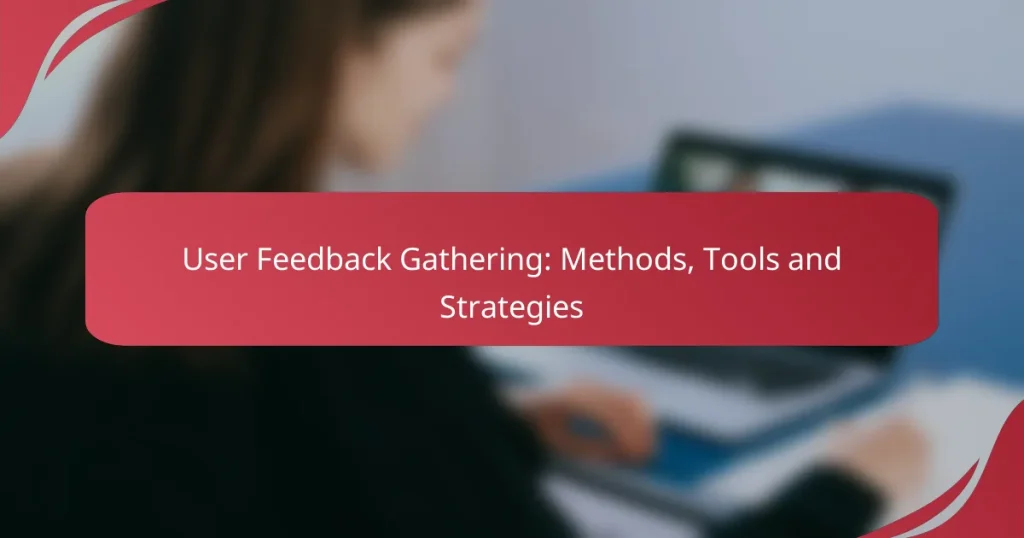Gathering user feedback is essential for understanding experiences and preferences, and it can be achieved through various tailored methods. By implementing effective tools and strategies, businesses can gain actionable insights that drive improvements and enhance overall user satisfaction.

What are the best methods for gathering user feedback?
The best methods for gathering user feedback include a variety of techniques tailored to different contexts and goals. Each method has unique advantages and can provide valuable insights into user experiences and preferences.
Surveys and questionnaires
Surveys and questionnaires are structured tools that collect user feedback through predefined questions. They can be distributed online or in person, allowing for a wide reach and quick data collection.
When designing surveys, focus on clarity and brevity to encourage participation. Aim for a mix of open-ended and closed questions to gather both quantitative and qualitative data. Tools like Google Forms or SurveyMonkey can facilitate this process.
User interviews
User interviews involve direct conversations with users to explore their experiences and opinions in depth. This qualitative method allows for follow-up questions and clarifications, providing richer insights.
Prepare a set of guiding questions but remain flexible to explore unexpected topics. Aim for interviews lasting 30-60 minutes to keep users engaged while gathering comprehensive feedback.
Focus groups
Focus groups bring together a small group of users to discuss their experiences and opinions about a product or service. This method encourages interaction and can reveal diverse perspectives.
Facilitate discussions by having a moderator guide the conversation and ensure all voices are heard. Sessions typically last 1-2 hours and can be conducted in-person or virtually. Be mindful of group dynamics, as dominant personalities may overshadow quieter participants.
Usability testing
Usability testing assesses how easily users can navigate a product or service. Participants are observed as they complete specific tasks, revealing pain points and areas for improvement.
Conduct tests with 5-10 users to identify common issues. Sessions should last about an hour, allowing time for task completion and follow-up questions. Use tools like Lookback or UserTesting to record sessions for later analysis.
Online reviews
Online reviews are unsolicited feedback left by users on platforms like Yelp, Google, or product-specific sites. They provide insights into user satisfaction and areas needing improvement.
Regularly monitor these reviews to identify trends and common issues. Responding to reviews can enhance customer relationships and demonstrate that feedback is valued. Aim to address negative feedback constructively to improve user perception.

How can e-commerce businesses implement feedback tools?
E-commerce businesses can implement feedback tools by selecting appropriate platforms that facilitate customer input and analyzing user behavior. These tools help in understanding customer preferences, improving services, and enhancing overall user experience.
Using SurveyMonkey for surveys
SurveyMonkey is a popular tool for creating and distributing surveys to gather customer feedback. E-commerce businesses can design custom surveys to assess customer satisfaction, product preferences, and service quality.
To maximize response rates, keep surveys concise and focused, ideally under 10 questions. Offer incentives, such as discounts or loyalty points, to encourage participation.
Employing Hotjar for user behavior analysis
Hotjar provides insights into user behavior through heatmaps, session recordings, and feedback polls. This tool allows e-commerce businesses to visualize how customers interact with their website, identifying areas for improvement.
Utilizing Hotjar’s features can help pinpoint navigation issues and optimize the user journey. Regularly review the data to adapt strategies and enhance the overall shopping experience.
Integrating Google Forms for feedback collection
Google Forms is a versatile tool for collecting feedback without any cost. E-commerce businesses can create simple forms to gather customer opinions on products, services, and overall satisfaction.
To ensure effective feedback collection, share the forms via email or social media and keep questions straightforward. Analyze the responses periodically to inform business decisions and improve customer engagement.

What are the key strategies for effective user feedback?
Effective user feedback strategies focus on gathering actionable insights that can enhance products or services. Key strategies include setting clear objectives, incentivizing participation, and analyzing feedback trends to drive improvements.
Establishing clear objectives
Setting clear objectives is crucial for effective user feedback. Define what you want to learn from the feedback process, such as understanding user satisfaction or identifying pain points in a product. This clarity helps in designing targeted surveys or interviews.
Consider using the SMART criteria—Specific, Measurable, Achievable, Relevant, Time-bound—to formulate your objectives. For example, instead of asking general questions, focus on specific features or user experiences to gain deeper insights.
Incentivizing participation
Incentivizing participation can significantly boost response rates for feedback initiatives. Offering rewards such as discounts, gift cards, or exclusive content encourages users to share their thoughts. Tailor incentives to your audience to maximize engagement.
Keep in mind that incentives should not compromise the authenticity of the feedback. Ensure that the rewards are appropriate and do not lead to biased responses. A balanced approach can yield honest insights while motivating users to participate.
Analyzing feedback trends
Analyzing feedback trends involves examining collected data to identify patterns and insights. Use qualitative and quantitative methods to assess user sentiments and preferences over time. This analysis can reveal recurring issues or highlight areas for improvement.
Utilize tools like spreadsheets or specialized software to visualize data trends. Look for common themes in open-ended responses and track changes in user satisfaction metrics. Regularly reviewing this information helps in making informed decisions and adjustments to your offerings.

How to choose the right feedback method for your audience?
Selecting the appropriate feedback method for your audience involves understanding their preferences and behaviors. Consider factors such as demographics, engagement levels, and the context in which feedback will be gathered to ensure effective communication.
Identifying target demographics
Understanding your target demographics is crucial for choosing the right feedback method. Analyze characteristics such as age, gender, location, and occupation to tailor your approach. For instance, younger audiences may prefer digital surveys, while older groups might respond better to phone interviews.
Utilize tools like Google Analytics or social media insights to gather data on your audience’s demographics. This information can guide your choice of feedback channels, ensuring they resonate with your specific user base.
Evaluating user engagement levels
Assessing user engagement levels helps determine the most effective feedback methods. Highly engaged users may be more willing to participate in detailed surveys or focus groups, while less engaged users might require simpler, quicker methods like polls or rating systems.
Consider using engagement metrics such as session duration, interaction rates, and feedback history to inform your strategy. For example, if users frequently abandon surveys, it may indicate a need for shorter, more straightforward questions to maintain their interest.

What are the challenges in gathering user feedback?
Gathering user feedback presents several challenges, including low response rates, potential bias in the feedback received, and concerns regarding data privacy. Addressing these issues is crucial for obtaining reliable and actionable insights.
Low response rates
Low response rates are a common challenge when collecting user feedback. Many users may ignore surveys or feedback requests due to time constraints or lack of interest. To improve response rates, consider using incentives, keeping surveys short, and targeting the right audience.
Utilizing multiple channels, such as email, in-app prompts, or social media, can also help reach a broader audience. Aim for a response rate of at least 10-20% for effective data collection.
Bias in feedback
Bias in feedback can skew results and lead to inaccurate conclusions. This bias may arise from leading questions, the demographic characteristics of respondents, or the method of data collection. To mitigate bias, ensure questions are neutral and varied in format.
Using a diverse sample group can also help reduce bias. For instance, if you primarily collect feedback from loyal customers, you may miss insights from new or dissatisfied users. Aim for a balanced representation of your user base.
Data privacy concerns
Data privacy concerns are increasingly important in user feedback gathering. Users may hesitate to provide feedback if they fear their personal information will be misused. To address these concerns, be transparent about how data will be used and ensure compliance with regulations like GDPR or CCPA.
Implementing secure data collection methods and anonymizing responses can also build trust with users. Clearly communicate your privacy policy and offer users the option to opt-out of data collection if they choose.

How can feedback improve e-commerce product offerings?
Feedback is essential for enhancing e-commerce product offerings by providing insights into customer preferences and pain points. By systematically gathering and analyzing feedback, businesses can make informed decisions that align their products with market demands.
Enhancing product features
Gathering user feedback allows e-commerce businesses to identify which product features resonate most with customers. For instance, if multiple users request a specific functionality, it may indicate a strong market demand. Prioritize these features in your development roadmap to stay competitive.
Consider using surveys or direct interviews to collect detailed insights on desired features. A simple rating scale can help quantify preferences, allowing you to focus on the most requested enhancements. Avoid overwhelming customers with too many questions; keep it concise to encourage participation.
Optimizing user experience
User feedback plays a critical role in refining the overall shopping experience. By analyzing comments and suggestions, you can pinpoint areas where customers face difficulties, such as navigation issues or checkout complications. Addressing these pain points can lead to higher conversion rates.
Implement usability testing sessions to observe real-time interactions with your site. This can uncover hidden obstacles that users may not explicitly mention. Additionally, consider A/B testing different layouts or features based on feedback to determine which versions yield better user engagement.


